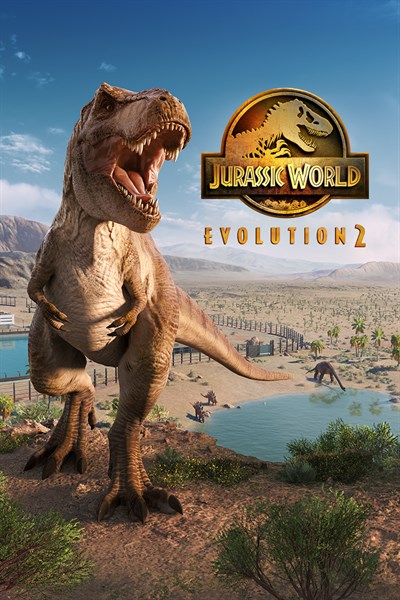Summary
- New DLC for Jurassic World Evolution 2 releases September 15 on Xbox One and Xbox Series X|S.
- Features four stunning new prehistoric species.
- Discover exciting species that roam the land, sea, and skies.
Following on from our last DLC, Jurassic World Evolution 2: Dominion Biosyn Expansion, we’re adding four more awe-inspiring prehistoric species to help you expand your ever-evolving dinosaur parks. This time we’ve delved deep into the fascinating Late Cretaceous era to bring you spectacular new additions across land, sea, and air. Introduce them to your park by buying the Late Cretaceous Pack on Xbox One and Xbox Series X|S when it releases tomorrow, September 15.
The Late Cretaceous age was a period over 65 million years ago that gave rise to all sorts of magnificent life forms. We chose to create this pack as the Cretaceous period had such diverse-looking species across the water, land, and air. It’s such a rich span of time to draw from, giving us amazing additions to Jurassic World Evolution 2, as well as making for a great companion to our Early Cretaceous Pack. So let’s explore the four new prehistoric animals featured in the soon to be released Late Cretaceous Pack.
First, Barbaridactylus, a flying hunter with a distinctive head crest. Our artists and designers have done a tremendous job bringing this species back to life. Barbaridactylus thrived towards the end of the Late Cretaceous age, and takes its name from the Barbary Coast of North Africa, near to where it was discovered. The Barbaridactylus is our first Nyctosaurid being added to the game and it’s really exciting to add a flying reptile with such a distinctive head crest. If you’ve not built an aviary in your park yet, I really recommend you get started so you can give a home to Barbaridactylus.

Next, Alamosaurus. This is a true titan, and one of the largest dinosaurs from North America. In fact, it can lay claim to being one of the largest dinosaurs ever. To give you an idea of its sheer scale, even its shinbone manages to outsize an average adult human. But that’s not all. Alamosaurus is armored too, sporting large spines running down its shoulders, back, and tail. With the Alamosaurus, I really like the shape and size of the neck – there’s a real heft to it as it moves around your parks.

Equally impressive is the medium-sized carnivore, Australovenator. Now, Australovenator is a speed demon, galloping around Late Cretaceous Australia with cheetah-like pace. Unlike a cheetah, however, this species has flexible, prehensile arms used for grabbing. In fact, one of my favorite elements is the unique animation for when the Australovenator reaches out and snags food. With its lightweight frame and hyper-mobility, this is an expert hunter excelling at stalking prey and running it down. Also, the patterning and colors on the Australovenator are some of my favorites. It has some really vibrant contrasting colors.
Another prehistoric animal we think you’ll love introducing into your park is Styxosaurus. This intimidating species is an efficient marine predator, ruling the waves with a lethal combination of large fins, streamlined shape, and deadly swiftness. Other than sounding very cool because it’s named after the River of Death, this is a great addition as it’s a marine reptile with bioluminescence to some of the pattern colors. At night, it’ll glow as it’s swimming around the lagoon.

Alongside the new pack, we will also be releasing free Update 4, with a range of new features coming your way. It contains improvements like the ability to wake up tranquillized dinosaurs using the new stimulant dart, either directly or through task assignment. And watch the skies, because flying reptiles can now attack capture team helicopters! There are also plenty of beautiful new lagoon decorations in the base-game update so you can personalize them, including banners, fountains, customizable lights, and even an Indominus rex skeleton, which can be placed at the bottom of the lagoon.
We’re so excited for you to give our latest DLC a go and discover the incredible new prehistoric animals waiting for you, as well as try out the all-new Update 4. Covering land, sea, and sky, they’re guaranteed to make amazing additions. Buy the Late Cretaceous Pack for Jurassic World Evolution 2 when it releases tomorrow on Xbox One and Xbox Series X|S and experience a world evolved!
NOTE: The Late Cretaceous Pack requires Jurassic Evolution 2 base game to play.
Jurassic World Evolution 2: Late Cretaceous Pack
Frontier Developments
Barbaridactylus, a flying hunter that lived towards the end of the Late Cretaceous era. With its magnificent head crest, Barbaridactylus will make a distinctive addition to your park. This species takes its name from the Barbary Coast of North Africa, near to where it was discovered. Alamosaurus, an armoured titan and one of the largest dinosaurs ever discovered, with shinbones taller than an adult human. Sporting large spines running down its shoulders, back and tail, Alamosaurus is a behemoth of an herbivore, presenting a serious challenge to potential predators. Australovenator, a fast and agile medium-sized carnivore that occupied Australia around 95 million years ago. Characterised by a lightweight frame, extremely sharp teeth, and flexible arms used for grabbing, Australovenator was perfectly built for stalking and running down prey. Styxosaurus, a marine species that ruled the Late Cretaceous waves. Its streamlined shape combined with sizable fins produces deadly undersea swiftness, making Styxosaurus one of the most efficient predators of its time. Try modifying its genome with diverse bioluminescent pattern colours.

Jurassic World Evolution 2
Frontier Developments


